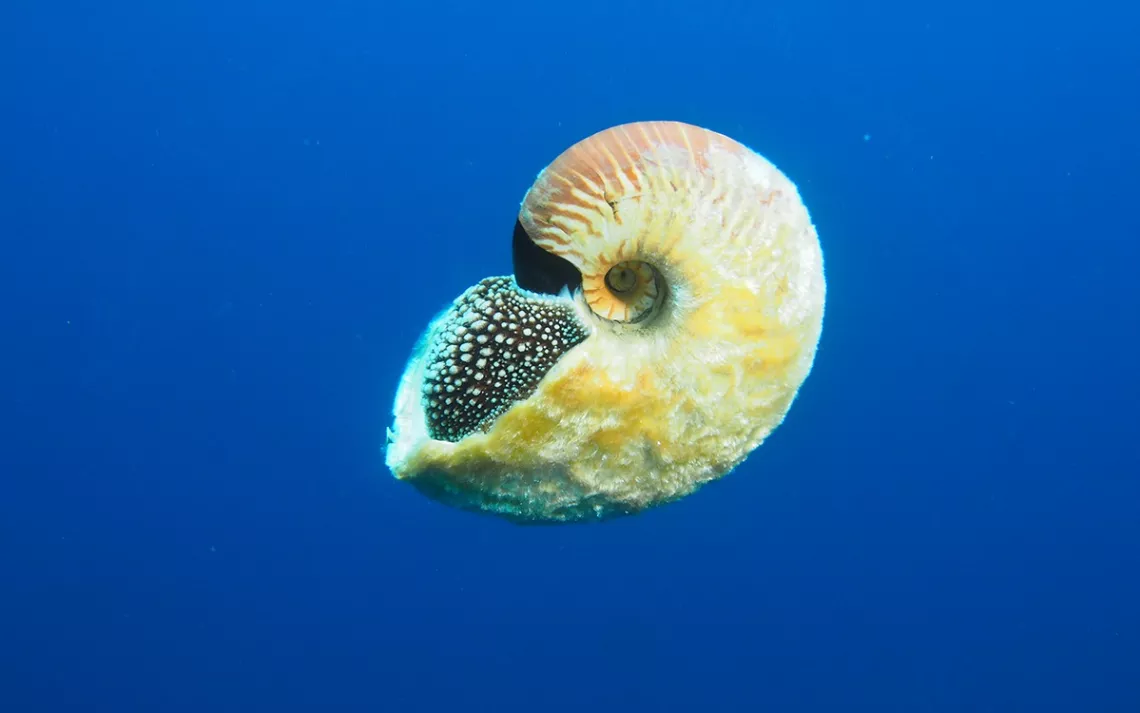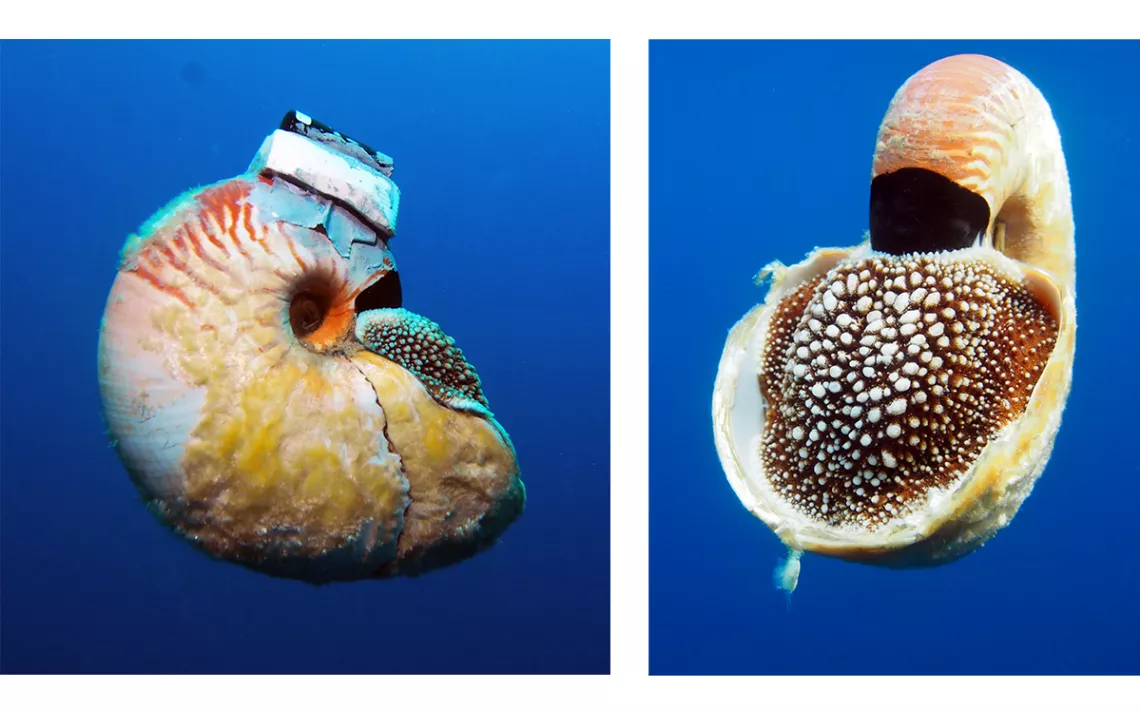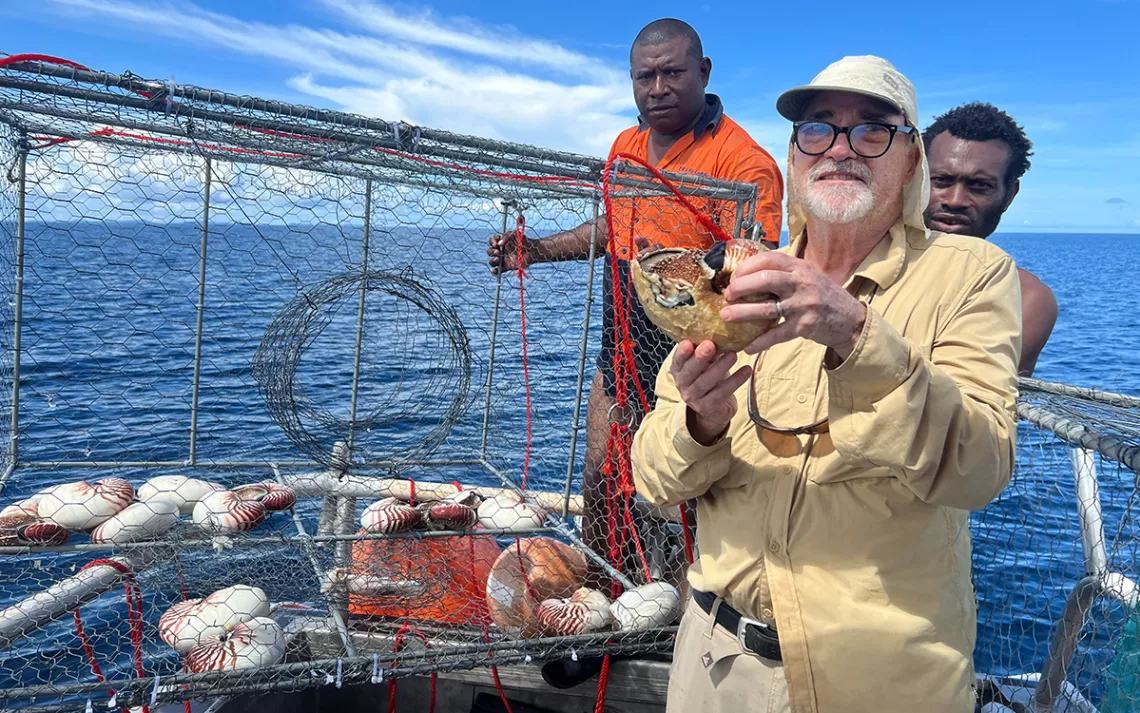The Mythical Golden Nautilus, Too Rare for Its Own Good
A slimy coat helps it avoid oceanic predators, but not shell collectors on eBay

Photos courtesy of Peter Ward
Marine biologist Gregory Barord remembers the anticipation building as he pulled a bulky nautilus trap back up from the ocean floor. It was heavy, and he had to struggle to haul the leaden box to the surface, but his excitement grew with each passing moment. He had already seen the bright-orange coat of the golden or “fuzzy” nautilus when he looked overboard 15 meters down. He knew his hard work was paying off.
It was March 2015, and Barord and his team had been in search of the golden nautilus for days in the waters off Papua New Guinea. Each trap had come up short until that lucky moment when he saw the almost mythical creature for the first time. “Once we pulled the fuzzy nautilus onto the boat, we could see its famous mucousy coat and the signature black coloring on its hood,” he says. “I just stared at it, knowing that it was likely older than me.”
Nautilus can live for decades, and their slimy coats help them evade predators, whose attacks were evident from the many shell breaks: “You can see all the places where something was trying to eat it and somehow it had lived.”
The scars tell a story of survival, in some cases, against great odds. The golden nautilus’s shell will implode if it sinks below 700 meters in the ocean and overheat under the sun if it floats to the surface. Compared with other nautiluses, the golden nautilus moves at a leisurely pace. “They never move fast, but when you look at underwater video of the golden nautilus, its movements are even slower,” Barord says. This could be because they live in areas where food is scarce, so their slow movement may help reduce their metabolic rate.
The species’ only known habitat is a narrow strip of water found off the coast of Papua New Guinea and the Solomon Islands. Barord has only seen a handful in his career, and he fears there aren’t many left beyond that. Some researchers have guessed at a few thousand, but they’re found so infrequently that it’s difficult to know for sure. Sometimes decades pass between sightings. It doesn’t make viewing easier that they’re nocturnal, hiding out in underwater caves during the day.


Peter Ward, a biology professor at the University of Washington
There’s a lot we don’t know about the golden nautilus, Barord says, but we do know that they’re relatively new to the world: DNA evidence shows that they’ve likely only been around for 2 million years compared with other species of nautilus that date back 100 million years.
Peter Ward, a biology professor at the University of Washington, remembers his first encounter just as vividly. It’s a curious creature, he says, so slippery it feels like you’re playing hot potato: “You think you have a good grip, but then it slips through your fingers.” Besides keeping predators at bay, the slippery coat holds the shell together, so even if it’s broken it’s still held in place.
Unfortunately for the golden nautilus, its rarity makes it extremely valuable to the illegal shell trade. Although all “chambered nautiluses” are protected under the Endangered Species Act, each shell can fetch thousands of dollars. According to Ward, illegal trapping often involves dredging the bottom of the ocean within a very delicate habitat and bringing up anything in the way. Confronting the poachers can be dangerous. “This is no joke shit; these people are armed and dangerous, similar to the elephant ivory trade,” Ward says.
So the shells of this endangered creature end up for sale on eBay for thousands of dollars. Sellers will say that they died, floated to the surface, and were then found on beaches. Ward is skeptical. Once they float to the surface, it’s so hot that their coveted color starts to fade and marine life almost immediately begins growing on them. Trapping a nautilus and pulling out its insides produces a better-looking and higher-priced shell. “These guys aren’t floating for long periods of time. They have all the hallmarks of brand-new, live-caught nautiluses,” Ward says of the shells offered for sale.
While the golden nautilus is the rarest species, it’s not the only target. All chambered nautiluses are valuable, as are other mollusks, and “deep water mining” for the shell trade is obliterating them all. Ward thinks that a big cultural shift is in order, to make buying nautiluses as unthinkable as buying rhino horns or elephant tusks. And online markets like eBay need to stop selling them. Barord and Ward both contend that the key is education. “We need to realize that while they’re beautiful, collecting them means killing them,” he says.
Barord hopes that future trips to Papua New Guinea will bring more encounters with the golden nautilus, but he’s worried. “They’re rare,” he says, “and that rarity is a doubled-edged sword.”
 The Magazine of The Sierra Club
The Magazine of The Sierra Club



